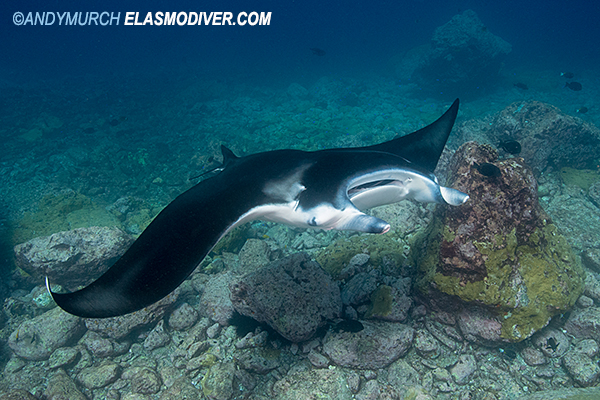

View all available
Reef Manta Ray Pictures
in the
Shark Pictures Database
Common
Names:
Reef manta
ray, Manta ray, Devil ray.
Scientific
Name:
Manta
alfredi
Family:
Mobulidae
Identification:
Immense size (the largest of all the rays
except for the closely related Manta birostris). Terminal mouth has well developed,
flexible cephalic lobes. Single small dorsal fin set close to tail. No bump at
base of dorsal. No caudal spine or cartilaginous mass at base of tail.
Tail thin (filamental) approximately 123% of body length.
Black and black/white colour variations have been
reported for this species. Body markings may be cryptic and often
lead to confusion with M.birostris therefore the following
characteristics should not be regarded as an identification tool:
Solid black or mostly black dorsum. Sometimes with symmetrical white patches
forming a subtle V across the shoulders. Ventrum white with
irregular dark spots and blotches. Often with dark blotches between the gills.
A thick, dusky band forming a chevron is often present along the
posterior margin of the ventrum.
Size:
Maximum wing span 5.5m but usually 3-4m. Disc width at birth 1.2m.
Habitat:
Oceanic and inshore waters. Adults usually seen
inshore. A regular visitor to seamounts where
plankton is forced to the warmer surface layers.
Abundance
and distribution: Tropical Indian Ocean and West Pacific. From the Red
Sea to South Africa in the west to Japan, Southeast Asia and Western
Australia and east to French Polynesia and Hawaii. Some reports from
the Canary Islands and Cape Verde may be attributed to M.birostris.
Behavior:
Manta rays
are often
seen where plankton is concentrated. They
unroll their cephalic lobes and use them to channel plankton into their mouths.
Occasionally they can be seen barrel-rolling in the water column when feeding.
They may also breach; perhaps to rid themselves
of parasites. Seen singly or in
aggregations where food (plankton) is abundant.
"Warm blooded" i.e. able to sustain higher temperatures within
their bodies
and brains relative to the ambient water temperature. This may be a tool
for maintaining constant muscle function whilst moving in and out of thermoclines.
Reproduction:
Ovoviviparous.
Gives birth to one or two pups.
Conservation
Status: Protected
under CITES Appendix II. Considered 'Vulnerable' by the IUCN.
Quote: "The rate of population reduction appears to be high in
several regions, up to as much as 80% over the last three
generations (approximately 75 years), and globally a decline of 30%
is strongly suspected. Currently this species has a high value in
international trade (its gill rakers are used in Chinese medicines)
and directed fisheries exist that target this species in what is
certain to be unsustainable numbers. Artisanal fisheries also exist
that target this species for food. Individuals are also taken as
bycatch in everything from large-scale fisheries to shark control
programs/bather protection nets. As a result of sustained pressure
from fishing (both directed and bycatch) certain monitored
subpopulations appear to have been depleted, such as in Indonesia.
Of particular concern is the targeting of this species at critical
habitats or well-known aggregation sites where, with relatively high
catch-per-unit effort, numerous individuals can be targeted
simultaneously or with relative ease.
Dive tourism involving this species is a growing industry and it has
been demonstrated that sustainable tourism significantly enhances
the economic value of such species in comparison to short-term
returns from fishing. Tourism related industries can also negatively
impact individual behaviour, entire populations and critical habitat
for this species, thus the responsible development of these
industries is recommended."
Citation: Marshall, A., Kashiwagi, T., Bennett, M.B.,
Deakos, M., Stevens, G., McGregor, F., Clark, T., Ishihara, H. &
Sato, K. 2011. Manta alfredi. The IUCN Red List of Threatened
Species. Version 2014.3. <www.iucnredlist.org>.
Photographs:
Nuku Hiva, Marquisas Archipelago, French
Polynesia.
Similar
species:
The reef manta is often confused with
the larger oceanic manta Manta birostris. Althouh very
similar, the oceanic manta has a distinct cartilaginous bulge at the
base of its tail behind the dorsal fin and no spots on its ventral
surface
between its gills.
Reaction
to divers: Sometimes curious
but usually moves away when approached closely.
Diving logistics:
There are many areas
throughout the Indo Pacific where reef mantas can be encountered. Contact
bigfishexpeditions.com
for information about trips to Nuku Hiva where reef mantas are seen on most
dives that are conducted. |























